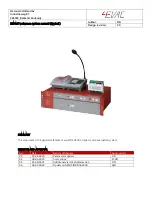
24
CHOOSE A FLOTATION DEVICE THAT YOU WILL WANT TO WEAR
A good choice for a flotation device is one that will offer sufficient
buoyancy for your size and body type to raise your airway (mouth
and nose) above water. Also important is comfort and mobility out
of the water so that it can be worn at all times during your boating
activity. An increased performance level (more flotation and turning)
should be considered when in rougher waters or when further
offshore where rescue assistance may be a long time coming. Some
activities require special features or accessories for better visibility, for
a more secure fit in wave conditions, and for thermal protection.
COLD SHOCK
Unexpected immersion (even in moderately cold water) can cause
involuntary gasping and loss of muscle control. It can take one
minute or more for these reactions to subside, and there is a risk of
inhaling water. You really need the support of a flotation device in this
situation. In colder water, swim failure can occur even for strong and
experienced swimmers. Trying to put on and fasten a flotation device
after immersion can be impossible. Remember that on a hot sunny
day the water can still be cool, and the effect of sudden immersion
is shocking to the nervous and breathing systems. Choosing a
comfortable device and being diligent about wearing it can save you
in these critical first moments.
HYPOTHERMIA
Prolonged immersion in cold water (after one hour or more) leads
to a loss of body heat. Over time (depending on water temperature,
body type, and thermal protection) the core temperature of the body
decreases. This produces a condition called hypothermia, which is
very serious and can lead to unconsciousness and circulatory failure.
Swimming and treading water accelerates heat loss. Wearing a
flotation device is essential to help you conserve body energy and
increase your survival time. It enables you to float quietly and curl up
arms and legs in a Heat Escape Lessening Posture (HELP) with the
head out of water, reducing heat loss from the head, under the arms,
and the groin area (see “HELP,” Fig. 13). If there is more than one
person in the water, gathering together in a huddle is recommended
while waiting to be rescued (see “Huddle,” Fig. 13).
Preparation, good safety practices, and strong spirit are the keys to
survival. Stay calm and don’t give up.
















































